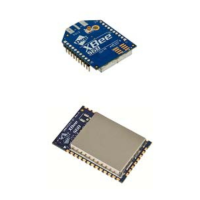XBee® Wi-Fi RF Modules
© 2013 Digi International, Inc. 50
SPI operation is similar except that the radio asserts nATTN when data becomes
available and then the local host is expected to assert SPI_nSSEL and to provide a clock
until the data available is sent out.
When the local UART host needs to send data it de-asserts SleepRq. Once the
appropriate status I/O lines are asserted (CTS and/or On/nSleep) the module is ready to
accept data. However data will be queued and not sent until the next DTIM.
When the local SPI host needs to send data it asserts SPI_nSSEL. If SPI_nSSEL is being
used for pin sleep, asserting SPI_nSSEL is enough to awaken the module to receive the
incoming data. But, if SleepRq is being used to control sleep, then SPI_nSSEL must be
asserted and SleepRq must be de-asserted to awaken the module to receive the data.
This wakes up the module, which will then accept the incoming data. However data will
be queued and not sent until the next DTIM.
Cyclic Sleep Mode
The module remains associated to the AP and will sleep based on the SP parameter.
After SP expires, the module will awaken for 30 milliseconds to check for data from the
AP and to allow the host to send data or commands. This time is factored in as part of
the overall ST time. When data is received or sent within 30 ms, the module will remain
awake for ST time and any further activity will not restart this time. When no data is
received or sent within 30 ms, the module will resume sleeping immediately, without
waiting for ST time-out.
Deep Sleep (Non-Associated Sleep)
This option allows the Wi-Fi circuitry to be powered down resulting in the lowest sleep
current (about 6 µA) but at the expense of losing packets received during the time the
module is asleep. This is because the access point will behave like the module is in full
power mode while it is asleep and it will not hold back packets until the module wakes
up.
Pin Sleep Mode
In this mode when SleepRq is asserted the module will power down the Wi-Fi circuitry.
When SleepRq is de-asserted the Wi-Fi circuitry is powered up. This causes the module
to associate to the access point for each wake event. If the module was associated
when it went to sleep, it should be ready to transmit data as soon as the On/Sleep pin
indicates that the module is awake. If the module was not associated when it went to
sleep, the host must wait until the module is associated before a transmission can occur.
(In API mode, a modem status frame will be received when the module becomes
associated. Outside of API mode, the AI command must be used to determine when the
module is associated.)
Cyclic Sleep Mode
In this mode the module will enter and exit sleep based on the SP, ST, and SA
commands. SP specifies the sleep time and ST specifies the wake time of the module
after it is associated. SA specifies the maximum time to wait for association before
starting the ST timer. If SA expires before the association process completes, then the

